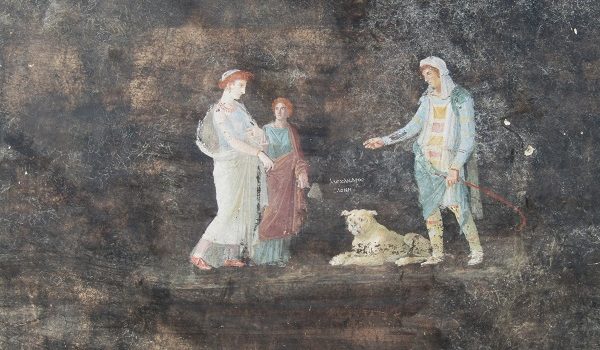Pompeii: a dining room decorated with characters and subjects inspired by the Trojan war has emerged from the new excavations
A spectacular banqueting room with elegant black walls, decorated with mythological characters and subjects inspired by the Trojan War, is one of the rooms recently been brought to light during the excavations currently underway in insula (block) 10 of Regio IX at Pompeii and which is now completely visible in all its splendour.
It provided a refined setting for entertainment during convivial moments, whether banquets or conversations, with the clear aim of pursuing an elegant lifestyle, reflected by the size of the space, the presence of frescoes and mosaics dating to the Third Style, the artistic quality of the paintings and the choice of characters.
The dominant theme seems to be that of heroism, shown by the depictions of pairs of heroes and deities involved in the Trojan War, but also of fate and, at the same time, of the possibility, often not seized, that humans have of changing their own destiny.
As well as Helen and Paris, indicated in a Greek inscription placed between the two figures with his other name “Alexandros”, there is the figure of Cassandra, the daughter of Priam, who is depicted on the walls of the dining room together with Apollo. In Greek mythology Cassandra was renowned for her gift of foresight and her terrible fate which prevented her from altering the course of future events. Despite her ability to predict the future, no one believed her as a result of a curse that Apollo put upon her for refusing to give herself to him, and she was therefore unable to prevent the tragic events of the Trojan War that she had foreseen. After being raped during the capture of Troy, she would end up being a slave of Agamemnon at Mycenae.
The frequent presence of mythological figures in the paintings of living rooms and dining rooms of Roman houses had the explicit social function of entertaining guests and table companions, providing talking points for conversations and reflections on life.
“The walls were painted black to prevent the smoke from the oil lamps being seen on the walls. People would meet to dine after sunset; the flickering light of the lamps had the effect of making the images appear to move, especially after a few glasses of good Campanian wine,” emphasises Gabriel Zuchtriegel, the Director of the Archaeological park of Pompeii. “The mythological couples provided ideas for conversations about the past and life, only seemingly of a merely romantic nature. In reality, they refer to the relationship between the individual and fate: Cassandra who can see the future but no one believes her, Apollo who sides with the Trojans against the Greek invaders, but being a god, cannot ensure victory, Helen and Paris who, despite their politically incorrect love affair, are the cause of the war, or perhaps merely a pretext. Who knows? These days, Helen and Paris represent us all: each day we can choose whether to focus solely on our own private lives or whether to explore the way our lives are entangled with the broad sweep of history, thinking for example, not just of war and politics, or of the environment, but also of the atmosphere we are creating in our society, communicating with others in real time and on social networks”.
The room is about fifteen metres long and six metres wide and opens onto a courtyard that seems to be an unroofed access room with a long undecorated staircase leading up to the first floor.
A huge pile of building materials that had been set aside was found beneath the arches of the staircase. Someone had drawn in charcoal two pairs of gladiators and what appears to be an enormous stylised phallus on the fresh plaster of the arches of the large staircase.
The excavation of insula 10 of Regio IX is part of a larger project designed to shore up the front of the perimeter between the excavated and unexcavated areas, and to improve the hydrogeological structure, aimed at making the vast heritage of Pompeii (over 13,000 rooms in 1070 residential units, besides public and sacred spaces) more efficient and sustainable.
The part of the area excavated so far has revealed two interconnected houses, a house with a bakery and a fullonica (laundry) overlooking via Nola, whose façades had already been brought to light in the late nineteenth century. Behind these two houses, sumptuous frescoed living rooms are now emerging which were also being renovated and restored at the time of the eruption, as has been described in a detailed analysis published in the e-journal of the excavations of Pompeii https://pompeiisites.org/e-journal-degli-scavi-di-pompei/


